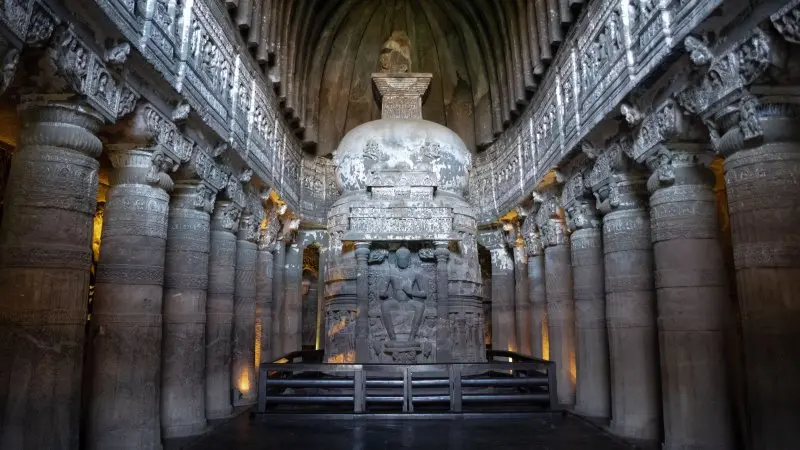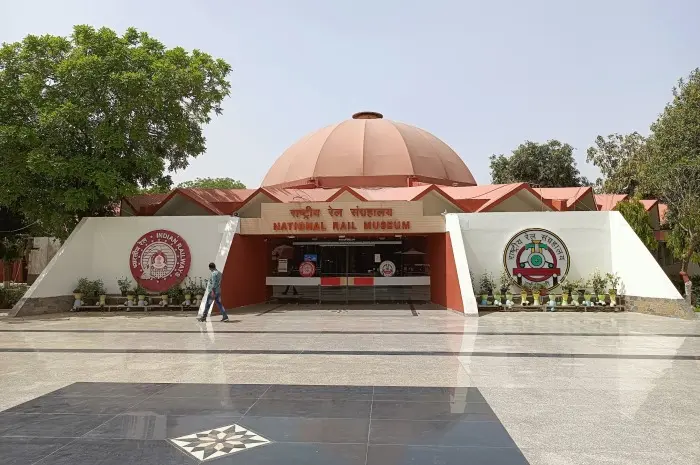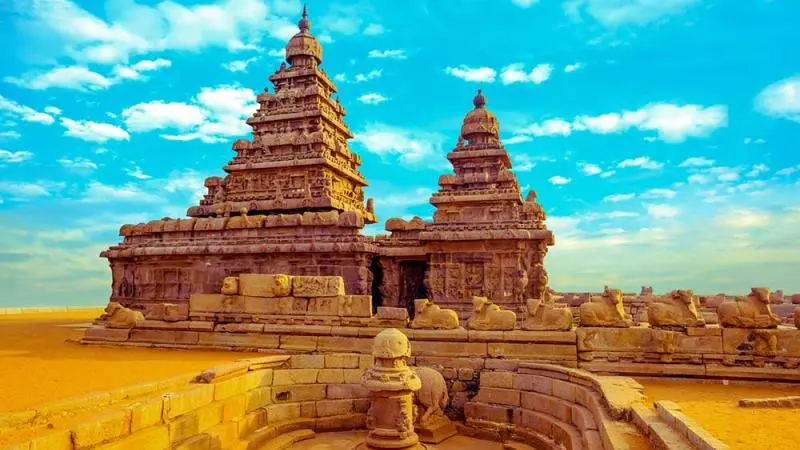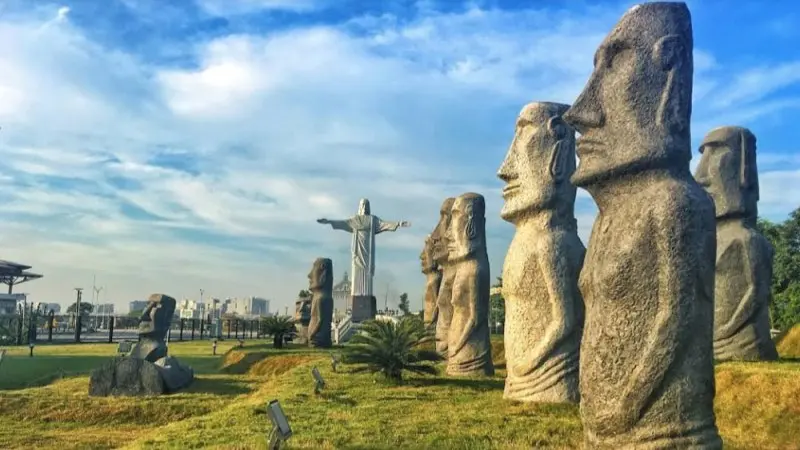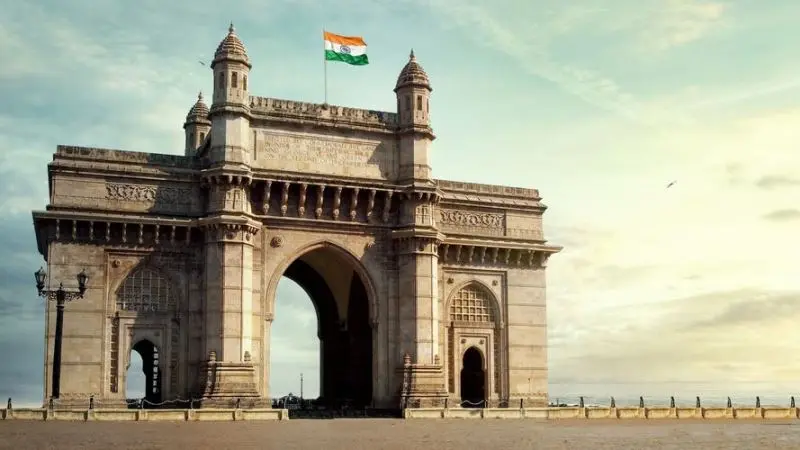| Entry Fee: 40 INR; Location: Check Map Address: Maharashtra 431117, India. |
The Ajanta Caves, nestled in the Sahyadri Hills in the Maharashtra state of Western India, are a spectacular collection of 30 rock-cut Buddhist caves. Revered for their architectural grandeur, intricate sculptures, and exquisite murals, these caves serve as a window into ancient Indian history and Buddhist religious art.
Recognizing their universal value, the Ajanta Caves were inscribed as a UNESCO World Heritage site in 1983. Today, they stand not only as a monument of religious importance but also as a testament to the artistic and technological achievements of ancient India. Their enduring charm continues to captivate scholars, art enthusiasts, and tourists from around the world.
1. History of Ajanta Caves
1. Time of Creation and Patronage
The Ajanta Caves were carved into the rocky cliffs of the Sahyadri Hills between the 2nd century BCE and the 6th century CE, spanning the Satavahana, Wakataka, and Gupta periods. The caves were patronized by various rulers, merchants, and individuals who donated resources for their construction and decoration as acts of religious merit.
2. Discovery of the Caves in Modern Times
After the decline of Buddhism in India, the caves were gradually abandoned and forgotten, hidden away by the dense surrounding vegetation. They were rediscovered by chance in 1819 by a British officer, John Smith, during a hunting expedition. Since then, the caves have attracted much attention from archaeologists, historians, and art scholars.
3. Significance in the Context of Indian History and Buddhism
The Ajanta Caves provide invaluable insights into the religious, historical, and cultural aspects of the time. They bear testament to the transition from Hinayana to Mahayana Buddhism, and the murals and sculptures vividly depict scenes from the Jataka tales, Buddha’s life, and the contemporary society. These artistic narrations serve as significant sources for understanding ancient Indian history and the development of Buddhist thought and art.
2. Description of the Caves
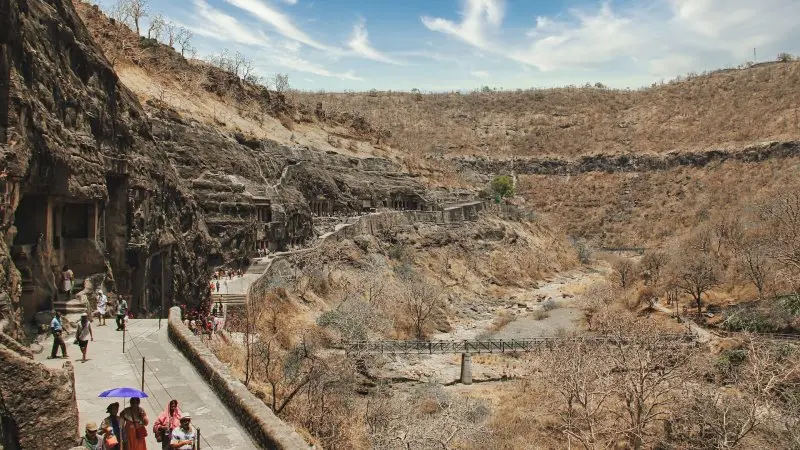
1. Number and Types of Caves
The Ajanta complex comprises 30 caves, each carved out of the rock face of a horseshoe-shaped cliff. These caves are broadly of two types: Chaitya-grihas, or prayer halls (Caves 9, 10, 19, 26, and 29), and Viharas, or monasteries (all other caves). The Chaitya-grihas contain stupas and were used for congregational worship, while the Viharas were used as living quarters for monks and also contain beautifully carved sculptures and paintings.
2. Unique Architectural Features of the Caves
The Ajanta Caves are renowned for their impressive architectural features. The Chaitya-grihas are characterized by large, vaulted chambers with a stupa at one end, and rows of pillars creating a nave and aisles. The facades of many caves are adorned with grand sculptures and decorative carvings.
The Viharas are typically square or rectangular, with a central hall surrounded by cells for monks. The caves also demonstrate advanced understanding of acoustics, lighting, and water management by the ancient builders.
3. Artistic Significance
1. Overview of the Murals and Sculptures in the Caves
The Ajanta Caves are a treasure trove of ancient Indian art, featuring both sculptures and paintings. The walls and ceilings of the caves are adorned with intricate murals painted with natural pigments. The subjects of these paintings range from depictions of the Buddha and Bodhisattvas to scenes from Jataka tales and contemporary society.
The caves also house an impressive array of sculptures, predominantly depicting the Buddha in various poses, along with other Buddhist figures. The sculptures, intricately carved out of rock, demonstrate a high degree of artistry and skill.
2. Themes and Stories Depicted in the Art
The art in the Ajanta Caves primarily revolves around Buddhist themes. The Jataka tales, which narrate stories about the previous lives of the Buddha, are frequently depicted. There are also numerous depictions of the Buddha’s life events, from his birth to his enlightenment and final nirvana. Additionally, the art presents a vivid portrayal of everyday life and society during the time, providing valuable insights into ancient Indian history.
3. Stylistic Features and Influences on Later Art Traditions
The Ajanta art is distinctive for its elegance, attention to detail, and rich color palette. The figures are characterized by their graceful postures and expressive faces. The art at Ajanta had a significant influence on Buddhist art in other parts of Asia and played a crucial role in shaping the artistic traditions of ancient India. It continues to inspire and influence art forms, research, and studies in the field of history, culture, and aesthetics.
4. Ajanta Caves and Tourism
1. Importance of Ajanta Caves as a Tourist Destination
The Ajanta Caves, with their historical, religious, and artistic significance, are one of India’s most popular tourist destinations. They attract visitors from across the globe, from historians and art enthusiasts to spiritual seekers and casual tourists. The breathtaking murals and sculptures, along with the caves’ architectural grandeur, offer an unparalleled experience of India’s ancient heritage.
2. Nearby Attractions and Facilities for Tourists
In addition to the caves, the region also hosts other attractions like the Ellora Caves and the Daulatabad Fort, making it a rich cultural hub for visitors. Facilities for tourists at Ajanta include a visitors’ center, guided tours, and audio-visual shows. Accommodation options ranging from budget to luxury are available in the nearby city of Aurangabad, which serves as a base for visiting the caves.
The government and tourism authorities have put in place several measures to ensure visitor comfort and accessibility while preserving the integrity of the site. Measures include restrictions on flash photography and touching the murals, to prevent damage. Despite these necessary restrictions, a visit to the Ajanta Caves promises to be a memorable journey into the artistic and cultural wealth of ancient India.
5. Conservation Efforts
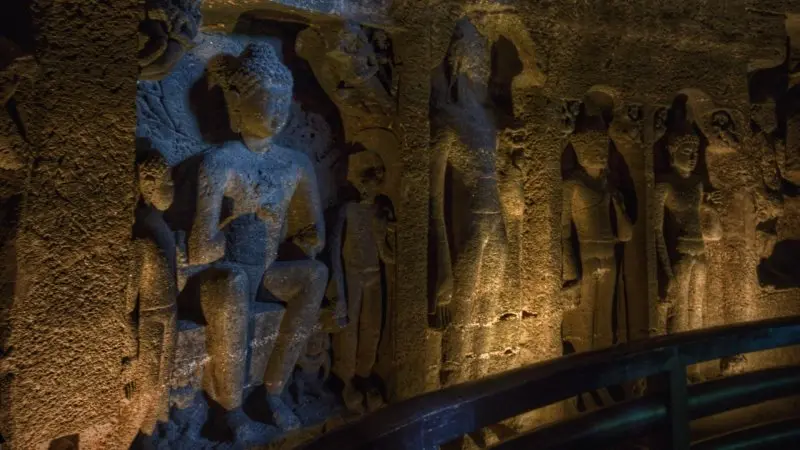
1. Challenges to Preservation
The Ajanta Caves, despite their architectural robustness, face several preservation challenges. The most significant threat is the gradual deterioration of the ancient murals due to environmental factors like humidity, temperature fluctuations, and water seepage. Additionally, human-induced factors like carbon dioxide from visitor breath, touching, and past unregulated tourism activities have contributed to the degradation of the caves.
2. Efforts by Archaeological Survey of India and UNESCO
Given the caves’ historical, cultural, and artistic significance, several concerted conservation efforts are underway. The Archaeological Survey of India (ASI), the body responsible for the preservation of the site, has undertaken numerous projects to combat the effects of natural weathering and human-induced damage.
Being a UNESCO World Heritage Site, the Ajanta Caves have also received international attention for their conservation. Alongside the ASI, UNESCO has initiated various preservation and restoration projects, which include controlling visitor numbers, regular monitoring, scientific conservation, and measures to improve the site’s infrastructure.
Conclusion
The Ajanta Caves, with their exceptional architecture, exquisite murals, and striking sculptures, represent a significant chapter in the annals of Indian and Buddhist history. They stand as an extraordinary testament to the artistic, religious, and cultural vigor of the periods they were created in. Each cave, with its unique design and artwork, narrates a story that resonates with historical, cultural, and aesthetic significance.
In the present context, the Ajanta Caves serve as an invaluable source of historical knowledge, artistic inspiration, and spiritual exploration. They play a critical role in promoting tourism in the region, contributing to the local and national economy. As a World Heritage Site, they hold a special place in the world’s cultural heritage.
Despite the challenges to their preservation, the Ajanta Caves continue to mesmerize visitors with their timeless beauty and profound symbolism. Their enduring appeal underscores the importance of ongoing conservation efforts to ensure that this precious link to our past remains undiminished for future generations. In conclusion, a visit to the Ajanta Caves is a journey into the depths of history, the heights of artistic excellence, and the profound teachings of Buddhism – a journey that leaves an indelible impression on the heart and mind.

